This article needs additional citations for verification .(December 2022) |

A party favor is a small gift given to the guests at a party as a gesture of thanks for their attendance, a memento of the occasion, or simply for fun. [1] [2]
This article needs additional citations for verification .(December 2022) |

A party favor is a small gift given to the guests at a party as a gesture of thanks for their attendance, a memento of the occasion, or simply for fun. [1] [2]
While the term "party favor" is modern, the practice dates back to the classical Graeco-Roman tradition, where food or flowers were gifted to the attendees of an event. In the Middle Ages entertainers were throwing small objects at the spectators, and the elaborate table decorations were sometimes gifted to important guests after the party. [3]
The origins of elaborate party favors at the weddings can probably be traced to the 20th-century marriage of Victor Emmanuel of Savoy to Elena of Montenegro, where the guests received silver items of significant value. [3] The tradition of sharing a wedding cake also represents gifting food to ensure good life and prosperity. [4] The almost extinct in Britain, but revived in the US, tradition of the groom's cake involved boxing its pieces to be given away to the guests. [5]
The bittersweet taste of sugarcoated almonds was thought to represent life since the times of Ancient Rome, so these are given away to wedding guests in Italy and Greece to represent indivisibility of marriage (thus usually in odd numbers) or, alternatively, in sets of five, health, wealth, happiness, fertility, and longevity. [5] Dutch people distribute five pieces of "bridal sweets" (Dutch : bruidssuikers) in tulle bags at their weddings. [6]
At the Malaysian weddings, gifts of hand-painted eggs represent fertility. Japanese distribute flowers, small bottles of sake, and sweets. Puerto Rican guests get the ornamented cards (Spanish : copia) listing the wedding date and the couple's names. Moslem celebrations might involve gifts of candy or eggs. [6]
Scottish weddings might have inedible favours attached to the cake and distributed to the guests by the bride. [5]
The party favors can be either directly given to each guest, placed at the table setting, or used as prizes to be won as part of the entertainment. [2]
A popular way of distributing the favors is a piñata, a vessel filled with candies and broken by the guests who take turns swinging a stick at it while blindfolded. The game might also involve searching for the favor, like in Easter egg hunt. [7]
Guests at the celebratory events (for example, weddings or birthdays) and gatherings for major holidays (like Christmas) might receive party favors; these vary in price and durability (but frequently are trinkets of small nominal value) in accordance with the desires and budget of the host or hostess. [2] This practice has spread to many other formal occasions such as baby showers, engagement parties, retirement parties, seasonal parties, once-in-a-lifetime events such as a Bar/Bat Mitzvah or Christening, and anniversaries.
For small social gatherings such as birthday parties, guests may receive a simple and inexpensive favor such as a small toy. In some cases guests might receive a small "gift bag", or "party bag" with a handful of favors, toys or trinkets, candy, pencils or other small gifts.

Wedding favors are small gifts given as a gesture of appreciation or gratitude to guests from the spouses during a wedding ceremony or a wedding reception.
The tradition of distributing wedding favors is hundreds of years old. It is believed that the first wedding favor, common amongst European aristocrats, was known as a bonbonniere. A bonbonniere is a small trinket box that was made of crystal, porcelain, and/or precious stones. The contents of these precious boxes were generally sugar cubes or delicate confections, which symbolize wealth and royalty.
As sugar became more affordable, bonbonnieres were replaced with almonds. For centuries, almonds were commonly distributed to wedding guests to signify well wishes on the bridegroom’s new life. In the thirteenth century, almonds coated with sugar, known as confetti, were introduced. Confetti soon transformed to sugared almonds, which started in ancient Greece and was inspired by the tale of Demophon, the king of Athens whose wife died and reincarnated as an almond tree. This later evolved into a wedding favor for modern day weddings. Traditionally, five Jordan almonds are presented in a confection box or wrapped in elegant fabric to represent fertility, longevity, wealth, health and happiness. [5] The bitterness of the almond and the sweetness of the coated candy are a metaphor for the bitter sweetness of a marriage.
Today, gifts to guests are commonly known as wedding favors and are shared in cultures worldwide. Wedding favors have become a part of wedding reception planning, especially in the United States and Canada. Wedding favors are diverse [6] and usually complement the theme or season of the event. Classic favors can range from the classic sugared almonds or individual chocolates to candles and scented soaps. Modern gift trends include: CDs with the favorite music of the bride and groom, shot glasses filled with colored candy or a charitable donation in the name of their guests. Gifts may also be personalized with the couple's or guest's names, initials or the wedding date.
At the Christmas and holiday season, a popular favor is a Christmas cracker that combines a saltpeter charge and a prize inside a cardboard tube. Tom Smith, traditionally considered to be an inventor of the crackers, also made them for other occasions like world fairs and overseas trips by British monarchs. [6]
A king cake is a popular way of distributing the favors through game of chance. It is typically served for the Feast of Epiphany and contains a figurine of a Christ child, its finder becomes the provider of the cake for the next year. The king cake might also contain a coin that obligates the finder to donate to a charity, and bean or pea crowning the finder as a king or queen of the day. In New Orleans, the cake is associated with Mardi Gras. [7]
The choice of favors is personal to the hosts, who might make or buy party favors for their event. The main factors in this decision are budget, the number of guests, the longevity or shelf life of the chosen favor, and the time available for making or shopping for favors. The longevity of the favor depends on whether or not it is edible or would otherwise spoil, such as fresh flowers.[ citation needed ]
Party favors may also refer to ephemeral items which help partygoers celebrate, but which are not meant to be lasting souvenirs. Examples include but are not limited to party hats, balloons, noisemakers, party horns (paper tubes that unroll when blown into), Christmas crackers, plastic leis, glow sticks, deely bobbers, and streamers and other kinds of confetti.[ citation needed ]

A wedding reception is a party usually held after the completion of a marriage ceremony as hospitality for those who have attended the wedding, hence the name reception: the couple receive society, in the form of family and friends, for the first time as a married couple. Hosts provide their choice of food and drink, although a wedding cake is popular.

Confectionery is the art of making confections, or sweet foods. Confections are items that are rich in sugar and carbohydrates although exact definitions are difficult. In general, however, confections are divided into two broad and somewhat overlapping categories: bakers' confections and sugar confections.
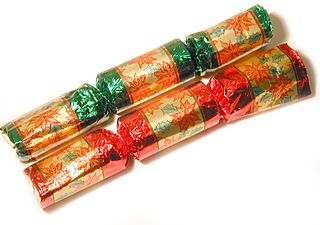
Christmas crackers are festive table decorations that make a snapping sound when pulled open, and typically contain a small gift, paper hat and a joke. They are part of Christmas celebrations in the United Kingdom, Ireland and Commonwealth countries such as Australia, Canada, New Zealand and South Africa.
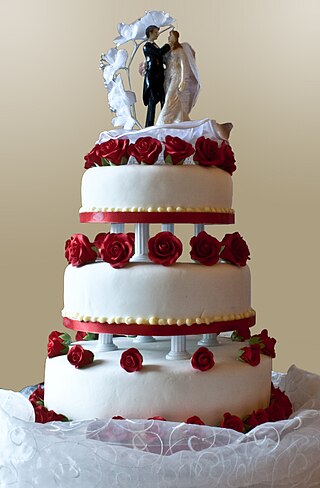
A wedding cake is the traditional cake served at wedding receptions following dinner. In some parts of England, the wedding cake is served at a wedding breakfast; the 'wedding breakfast' does not mean the meal will be held in the morning, but at a time following the ceremony on the same day. In modern Western culture, the cake is usually on display and served to guests at the reception. Traditionally, wedding cakes were made to bring good luck to all guests and the couple. Nowadays, however, they are more of a centerpiece to the wedding and are not always even served to the guests. Some cakes are built with only a single edible tier for the bride and groom to share, but this is rare since the cost difference between fake and real tiers is minimal.

Marzipan is a confection consisting primarily of sugar and almond meal, sometimes augmented with almond oil or extract.
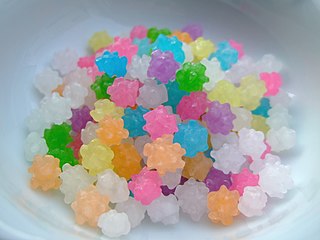
Konpeitō, also spelled kompeitō, is a type of Japanese sugar candy. It takes the form of a small sphere with a bumpy surface, and comes in a variety of colors and flavors. Introduced from Portugal as a sugar-coated confection with a poppy seed or sesame seed center, konpeitō was eventually transformed into an all-sugar confection with a zarame center.

Sprinkles are small pieces of confectionery used as an often colourful decoration or to add texture to desserts such as brownies, cupcakes, doughnuts or ice cream. The tiny candies are produced in a variety of colors and are generally used as a topping or a decorative element. The Dictionary of American Regional English defines them as "tiny balls or rod-shaped bits of candy used as a topping for ice-cream, cakes and other."

Confetti are small pieces or streamers of paper, mylar, or metallic material which are usually thrown at celebrations, especially parades and weddings. The origins are from the Latin confectum, with confetti the plural of Italian confetto, small sweet. Modern paper confetti trace back to symbolic rituals of tossing grains and sweets during special occasions, traditional for numerous cultures throughout history as an ancient custom dating back to pagan times, but adapted from sweets and grains to paper through the centuries. Confetti are manufactured in multiple colors, and commercially available confetti come in many different shapes. A distinction is made between confetti and glitter; glitter is smaller than confetti and is universally shiny. Most table confetti is also shiny. While they are called metallic confetti they are actually metallized PVC. Most party supply stores carry paper and metallic confetti. Confetti are commonly used at social gatherings such as parties, weddings, and Bar Mitzvahs. The simplest confetti are simply shredded paper, and can be made with scissors or a paper shredder. Chads punched out of scrap paper are also common. A hole punch makes small round chads, and a ticket punch makes more elaborate chads. Most pieces of paper flats will flutter as tumblewings giving long flight times.

Nonpareils are a decorative confectionery of tiny balls made with sugar and starch, traditionally an opaque white but now available in many colors. They are also known as hundreds and thousands in Australia, New Zealand, South Africa and the United Kingdom. In the United States, the same confectionery topping would generally be referred to among the general public as "sprinkles," regardless of their composition.
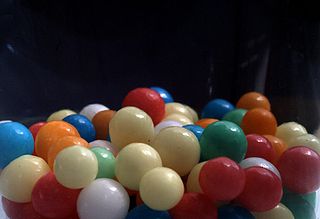
A dragée is a bite-sized confectionery with a hard outer shell.

A bomboniere, singular "bomboniera", is a kind of fragrant-smelling party favor given out on special occasions such as weddings, baptism, First Communion or Confirmation. It usually consists of five Jordan almonds in a festive bag, with the almonds symbolizing health, wealth, happiness, fertility and long life.

kransekage or Kransekake (Norwegian) is a traditional Danish and Norwegian confection, often eaten on special occasions in Scandinavia. In English, the name means 'wreath cake'. In Norway it is alternatively referred to as tårnkake and often prepared for Constitution Day celebrations, Christmas, weddings, and baptisms. In Denmark it is typically eaten as part of New Year celebrations, while a variation of the cake, overflødighedshorn, is traditionally served at weddings and baptisms.
Iranian wedding, also known as Persian wedding, consists of traditions rooted in Zoroastrianism, the primary religion of pre-Islamic Iran. Though the concepts and theories of marriage have been changed by Islamic traditions, the ceremonies have remained more or less the same as they were originally in pre-Islamic Iran. Although modern-day Iran is a multi-ethnic country, Iranian wedding traditions are embraced by the majority of ethnic groups in Iran.

Jul, the Danish Jule and Christmas, is celebrated throughout December starting either at the beginning of Advent or on 1 December with a variety of traditions. Christmas Eve, Juleaften, the main event of Jul, is celebrated on the evening of 24 December, the evening before the two Christmas holidays, 25 and 26 December. Celebrating on the eve before Christmas is also used for most other holidays in Denmark.
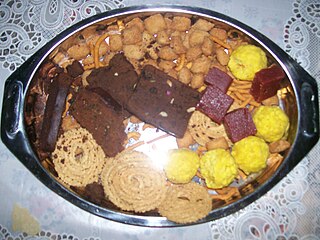
Kuswar or Kuswad is a set of festive sweets and snacks made and exchanged by Christians of the Konkan region in the Indian subcontinent for the Christmas season or Christmastide. These goodies are major parts of the cuisines of the Goan Catholic community of Goa in the Konkan region, and the Mangalorean Catholic community of Karnataka. There are as many as 22 different ethnic recipes that form this distinct flavour of Christmas celebration in Goa and Mangalore. Kuswad is also made and exchanged by Karwari Catholics of Carnataca and the Kudali Catholics of Sindhudurg, in the Konkan division of Maharashtra.
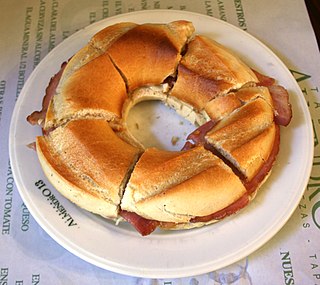
Rosca is a Spanish and Portuguese bread dish eaten in Spain, Mexico, South America, and other areas. It is made with flour, salt, sugar, butter, yeast, water, and seasonings. It is also called ka'ake and referred to as a "Syrian-style cracker ring".

Vanparys Confiserie B.V. is a Belgian confectionery company founded in 1769 by Felix Vanparys in Brussels, near Sablon, Belgium. The company produces chocolate and sugar-coated confections but specializes in dragées, which features often in Christian and Islamic traditions and celebrations. The recipe and the preparation of its dragées, dates back over 125 years ago, and are still being continued today.

Thomas Smith was a British baker and confectioner who is traditionally described as the inventor of the Christmas cracker, in 1847.